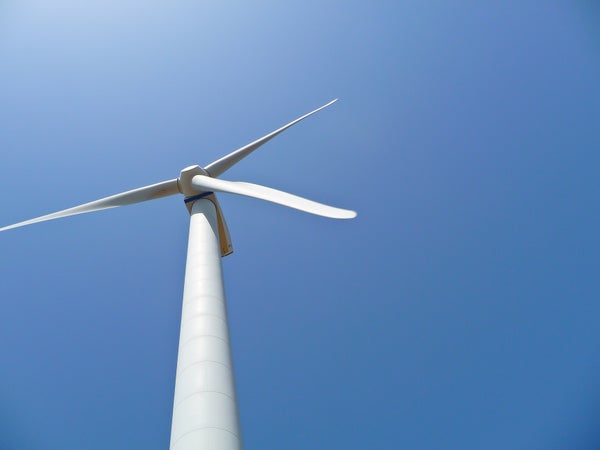Google Inc.’s investment in Kenya’s Lake Turkana Wind Power Project is its largest on the African continent to date, but it almost certainly won’t be the last.
The California internet giant has shown a growing interest in sub-Saharan Africa since it made its first cash outlay three years ago—a $12 million investment in the Jasper Solar Power Project in South Africa’s Northern Cape Province.
The 96-megawatt photovoltaic project, completed in 2014, was built by U.S.-based SolarReserve LLC and is capable of powering roughly 80,000 South African homes.
On supporting science journalism
If you're enjoying this article, consider supporting our award-winning journalism by subscribing. By purchasing a subscription you are helping to ensure the future of impactful stories about the discoveries and ideas shaping our world today.
The Lake Turkana deal, whose financial terms were not disclosed, calls for Google to acquire 12.5 percent of the nearly $700 million project from Vestas Wind Systems A/S of Denmark after the wind farm is completed next year.
“We are investing in clean energy projects like Lake Turkana because they make business sense and can help accelerate the deployment of renewable energy,” a Google spokesperson said in an email to E&E News.
She added that the company sees “a large opportunity in fast-growing markets with rich renewable energy resources, where both the need and the potential are great.”
The ownership group includes lead developers Aldwych International Ltd. of Great Britain and KP&P Africa BV of the Netherlands, with additional financial support from international development funds in Norway, Finland and Denmark.
As with Jasper in South Africa, Google said its wind power investment “will help bring much needed capacity and stability to Kenya’s energy supply, reducing reliance on fossil fuels and emergency diesel generation while providing some of the most cost effective power in the country.”
In total, Google has committed more than $2.5 billion to 22 renewable energy projects around the world, mostly through power purchase agreements and direct ownership of wind and solar farms, officials said. Much of its purchased power goes to support massive Google data centers in the United States and Europe.
But the company sees a future in the developing world, where millions of new internet users are coming online annually.
Part of an African investment boom?
Experts have noted that sub-Saharan Africa is one of the largest untapped markets for advanced telecommunications and digital networks, and Google has already taken steps to build its presence across the continent, both physically and digitally.
For example, Google has invested millions of dollars to construct fiber optic networks in the capital cities of Kampala, Uganda, and Accra, Ghana, where internet speeds and wireless connectivity were previously limited by old or nonexistent infrastructure.
The effort, called Project Link, also created one of Africa’s most extensive high-speed Wi-Fi networks across Kampala, allowing mobile phone users to access the internet from 120 sites in the city.
By purchasing a multimillion-dollar stake in the Lake Turkana project, Google will become the first U.S. firm to invest in a major sub-Saharan wind energy project (General Electric Co. has committed to provide turbines to at least one other Kenyan wind farm still in the planning phases).
It will also establish Google in the vanguard among private investors in Africa’s fast-growing clean energy market, which experts believe could become one of the world’s strongest by the mid-21st century.
“lf you look at where Africa was five or 10 years ago, basically it was nowhere,” said Achim Steiner, former executive director of the U.N. Environment Programme and U.N. undersecretary-general, who now leads the Oxford Martin School at Oxford University.
“Now we’re seeing billions of dollars of investment going in,” he added, in part thanks to firms like Google that have responded to “a very strong signal from African leaders” that the continent has both the capacity and the will to develop clean energy at scale.
Steiner noted that even before Google’s involvement, primary investors showed courage in moving ahead with Lake Turkana after the World Bank declined to provide loan guarantees to the project in 2012.
Instead, developers relied on backing from the European Investment Bank, the African Development Bank and the U.S. Overseas Private Investment Corp. (OPIC), which in 2014 committed $250 million in underwriting for Lake Turkana as part of its partnership with the Obama administration’s Power Africa initiative.
A spokeswoman for OPIC declined to comment on the project, saying in an email that the agency had not financially closed the deal.
Google also isn’t saying much about its aspirations for Lake Turkana, though the spokesperson made clear that the company intends to meet the terms of its purchase agreement with Vestas.
Google also noted that Lake Turkana serves as an anchor project for additional energy development in Kenya, including a more than 250-mile-long power transmission line that should link the wind farm to the Kenyan electricity grid and provide a conduit for another energy development in the Great Rift Valley, including thousands of megawatts of geothermal energy capacity.
Once it finalizes the purchase agreement next year, Google “will work collaboratively with our co-investors to ensure the success of the Lake Turkana project,” the spokesperson said. But she clarified that the company will have little involvement in the day-to-day operations of the wind farm and has not determined whether it will participate in broader decisions as part of an ownership group.
Google will earn a return on its investments through a share in profits earned from the sale of electricity to the national utility, Kenya Electricity Generating Co.
Reprinted from ClimateWire with permission from Environment & Energy Publishing, LLC. E&E provides daily coverage of essential energy and environmental news at www.eenews.net. Click here for the original story.
